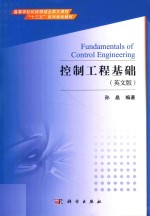

控制工程基础 英文版PDF电子书下载
- 电子书积分:9 积分如何计算积分?
- 作 者:孙晶编著
- 出 版 社:北京:科学出版社
- 出版年份:2017
- ISBN:9787030510518
- 页数:200 页
Chapter 1 Introduction 1
1.1 System and System Analysis 1
1.2 Modeling the System 2
1.3 Solving the Model 4
1.4 Principle of Automatic Control Systems 5
1.4.1 Control and Control Systems 5
1.4.2 How Does an Automatic Control System Work? 6
1.5 Structure of Control Systems 8
1.5.1 Schematic Diagram for a Typical Automatic Control System 8
1.5.2 Terminologies 9
1.6 Characteristics of Control Systems 10
1.6.1 Stability 10
1.6.2 Accuracy 10
1.6.3 Dynamic Properties 11
1.6.4 Robustness 12
1.7 Classification of Control Systems(to Broadest Sense) 12
1.7.1 Open Loop Control System 12
1.7.2 Closed Loop Control System 13
1.8 Application of Control Theory in Mechanical Engineering Systems 15
1.9 Brief History of Automatic Control 15
1.10 Organization of Book 17
1.11 Drill Problems 17
Chapter 2 Laplace Transform Solution 19
2.1 Definition 19
2.2 Laplace Transforms of Common Functions 20
2.2.1 Step Function 20
2.2.2 Ramp Function 20
2.2.3 Pulse Function 21
2.2.4 Exponential Function 22
2.2.5 Trigonometric Function 22
2.2.6 Power Function 23
2.2.7 Summary 23
2.3 Laplace Transform Properties 24
2.3.1 Multiplication by a Constant 25
2.3.2 Superposition 25
2.3.3 Differential Theorem 25
2.3.4 Integral Theorem 26
2.3.5 Initial Value Theorem 27
2.3.6 Final Value Theorem 27
2.3.7 Shifting Theorem in Time Domain(Delay Theorem) 28
2.3.8 Shifting Theorem in Complex Domain 28
2.3.9 Partial Fraction Method 28
2.4 Laplace Transform Inversion 30
2.4.1 Distinct Poles 31
2.4.2 Repeated Poles 33
2.4.3 Complex Poles 34
2.5 Drill Problems 36
Chapter 3 Formulation and Dynamic Behavior of Translational Mechanical Systems 37
3.1 Introduction 37
3.1.1 Concepts of Mathematical Models 37
3.1.2 Types or Mathematical Models 37
3.2 Variables 37
3.3 Element Laws 39
3.3.1 Mass 39
3.3.2 Friction 40
3.3.3 Stiffness 42
3.4 Interconnection Laws 43
3.4.1 D'Alembert's Law 43
3.4.2 The Law of Reaction Forces 44
3.5 Obraining the System Model 44
3.5.1 Free-Body Diagrams 45
3.5.2 Parallel Combinations 49
3.5.3 Series Combinations 50
3.6 Drill Problems 53
Chapter 4 Formulation and Dynamic Behavior of Electrical Systems 55
4.1 Element Laws 55
4.1.1 Resistor 55
4.1.2 Capacitor 56
4.1.3 Inductor 56
4.2 Interconnection Laws 57
4.2.1 Kirchhoff's Voltage Law 57
4.2.2 Kirchhoff's Current Law 58
4.2.3 The Nodal Method of Electrical Network Analysis 58
4.3 Analogue relationships among different systems 59
4.4 Examples 60
4.5 Drill Problems 62
Chapter 5 Fundamentals of Control Systems 63
5.1 Representation of Control Systems 63
5.2 The Transfer Function 63
5.2.1 Definition of the Transfer Function 64
5.2.2 Properties of the Transfer Function 65
5.2.3 The Rational Polynomial Form of a Transfer Function 66
5.2.4 Transfer Function of Elements in Series Connection 67
5.2.5 Transfer Function of Elements in Parallel Connection 68
5.2.6 Remarks 69
5.3 The Transfer Function for Typical Links 70
5.3.1 Proportion Link 70
5.3.2 Integral Link 71
5.3.3 Inertial Link 72
5.3.4 Differential Link 74
5.3.5 Oscillation Link 75
5.4 Function Block Diagrams 76
5.4.1 Introduction 76
5.4.2 Summing Point and Tie Point 76
5.4.3 Terminologies 77
5.4.4 Simplification of the Function Block Diagram 79
5.5 Plot the Function Block Diagrams 88
5.6 Signal Flow Diagrams 92
5.6.1 Introduction to Signal Flow Diagrams 92
5.6.2 Draw the Signal Flow Diagram 92
5.6.3 Mason's Gain Formula 94
5.7 Drill Problems 96
Chapter 6 Time Response Analysis of Control Systems 99
6.1 Introduction 99
6.2 Time Response from Transfer Function 100
6.2.1 Response of First-Order System 100
6.2.2 Response of Second-Order System 104
6.2.3 Approximate Analysis of High-Order System 110
6.3 Performance Specifications in Time Domain 114
6.3.1 Performance Specifications of First-Order System 114
6.3.2 Performance Specifications of Second-Order System 116
6.4 Drill Problems 121
Chapter 7 Frequency Response Analysis of Control Systems 123
7.1 Concepts 123
7.2 Graphical Descriptions:Nyquist Diagram and Bode Diagram 127
7.2.1 Simple Rules for Plotting Nyquist Diagram 127
7.2.2 The Nyquist Diagrams for Typical Links 128
7.2.3 Simple Rules for Plotting Bode Diagrams 134
7.2.4 The Bode Diagrams for Typical Links 139
7.3 The Open Loop Bode Diagram of Control System 151
7.4 Minimum Phase Systems 155
7.5 Nyquist Stability Criterion 158
7.5.1 The Explanation for Nyquist Stability Criterion 158
7.5.2 Some Tips for Nyquist Stability Criterion 160
7.5.3 Nyquist Stability Criterion for Minimum Phase System 161
7.5.4 Stability Margin 161
7.6 Drill Problems 167
Chapter 8 Stability Analysis of Control Systems 168
8.1 Stability 168
8.2 Conditions for the System Stability 169
8.3 Routh-Hurwitz Stability Criterion 170
8.3.1 The Preconditions for Routh-Hurwitz Stability Criterion 170
8.3.2 Full Condition for Routh-Hurwitz Stability Criterion 171
8.3.3 Special Cases for Routh-Hurwitz Stability Criterion 176
8.4 Drill Problems 181
Chapter 9 Error Analysis and Calculation of Control Systems 182
9.1 Terminologies 183
9.1.1 Deviation 183
9.1.2 Steady-State Deviation 183
9.1.3 Desired Output Value 183
9.1.4 Error 184
9.1.5 Steady-State Error 185
9.2 Static Error Coefficients 186
9.2.1 Two Impact Factors of the Steady-State Error 186
9.2.2 The Static Error Coefficients and the Steady-State Error 186
9.3 Steady-State Error Calculation 191
9.3.1 Steady-State Deviation Calculation 191
9.3.2 Steady-State Error Calculation 193
9.4 Methods for Reducing Steady-State Error 194
9.4.1 Increase Open Loop Gain 195
9.4.2 Increasing System Types 195
9.4.3 Feed Forward Control 196
9.4.4 Compound Control 198
9.5 Drill Problems 199
References 200
- 《市政工程基础》杨岚编著 2009
- 《零基础学会素描》王金著 2019
- 《计算机网络与通信基础》谢雨飞,田启川编著 2019
- 《生物质甘油共气化制氢基础研究》赵丽霞 2019
- 《工程静力学》王科盛主编 2019
- 《花时间 我的第一堂花艺课 插花基础技法篇》(日)花时间编辑部编;陈洁责编;冯莹莹译 2020
- 《中央财政支持提升专业服务产业发展能力项目水利工程专业课程建设成果 设施农业工程技术》赵英编 2018
- 《Photoshop CC 2018基础教程》温培利,付华编著 2019
- 《看视频零基础学英语口语》宋德伟 2019
- 《化学反应工程》许志美主编 2019
- 《市政工程基础》杨岚编著 2009
- 《家畜百宝 猪、牛、羊、鸡的综合利用》山西省商业厅组织技术处编著 1959
- 《《道德经》200句》崇贤书院编著 2018
- 《高级英语阅读与听说教程》刘秀梅编著 2019
- 《计算机网络与通信基础》谢雨飞,田启川编著 2019
- 《看图自学吉他弹唱教程》陈飞编著 2019
- 《法语词汇认知联想记忆法》刘莲编著 2020
- 《培智学校义务教育实验教科书教师教学用书 生活适应 二年级 上》人民教育出版社,课程教材研究所,特殊教育课程教材研究中心编著 2019
- 《国家社科基金项目申报规范 技巧与案例 第3版 2020》文传浩,夏宇编著 2019
- 《流体力学》张扬军,彭杰,诸葛伟林编著 2019
- 《指向核心素养 北京十一学校名师教学设计 英语 七年级 上 配人教版》周志英总主编 2019
- 《《走近科学》精选丛书 中国UFO悬案调查》郭之文 2019
- 《北京生态环境保护》《北京环境保护丛书》编委会编著 2018
- 《中医骨伤科学》赵文海,张俐,温建民著 2017
- 《美国小学分级阅读 二级D 地球科学&物质科学》本书编委会 2016
- 《指向核心素养 北京十一学校名师教学设计 英语 九年级 上 配人教版》周志英总主编 2019
- 《强磁场下的基础科学问题》中国科学院编 2020
- 《小牛顿科学故事馆 进化论的故事》小牛顿科学教育公司编辑团队 2018
- 《小牛顿科学故事馆 医学的故事》小牛顿科学教育公司编辑团队 2018
- 《高等院校旅游专业系列教材 旅游企业岗位培训系列教材 新编北京导游英语》杨昆,鄢莉,谭明华 2019
